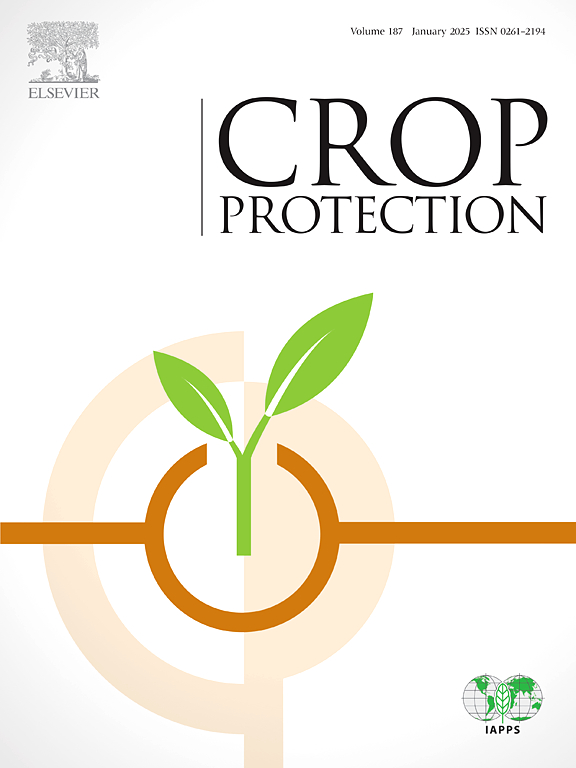Differential responses of weeds and rice to shading stress from oilseed rape straw mulch
IF 2.5
2区 农林科学
Q1 AGRONOMY
引用次数: 0
Abstract
Oilseed rape (Brassica napus L.) straw mulch suppresses weeds in rice (Oryza sativa L.) cropping systems. This study explores the role of shading in weed suppression by straw mulch through three experiments. The first experiment determined how oilseed rape straw length (powder or 1, 3, 5, 7, or 9 cm), application rate (100, 300, 500, 700, 900 or 1100 g m−2), and moisture (dry or wet) affect shading. Shading was greater with shorter straw lengths, higher application rates, and dry straw. When wet 1 cm straw was applied at the rates above, it blocked 52%, 87%, 96%, 99%, 99% and 99% of light, respectively. The second experiment evaluated germination of rice and seven weeds under an alternating light/dark regime compared with continuous darkness. Rice germination did not differ between the two treatments. Two weed species, barnyardgrass (Echinochloa crus-galli (L.) P. Beauv.) and Chinese sprangletop (Leptochloa chinensis (L.) Nees), exhibited some germination in continuous darkness but higher germination in the light/dark treatment. The remaining five weed species, small-flowered nutsedge (Cyperus difformis L.), eclipta (Eclipta prostrata (L.) L.), eared redstem (Ammannia auriculata Willd.), ricefield flatsedge (Cyperus iria L.), and grasslike fimbry (Fimbristylis littoralis Gaudich.) failed to germinate under the dark treatment. The third experiment measured effects of shading on seedling growth of rice and two weed species, barnyardgrass and eclipta. A few weeks of shading triggered shade avoidance responses and inhibited seedling growth in all three species. These findings demonstrate that oilseed rape straw mulch can effectively reduce weed germination and early growth through shading. This practice does not threaten rice establishment, and indeed may protect rice from later weed–crop competition for light.
杂草和水稻对油菜秸秆覆盖物遮阳压力的不同反应
油菜(Brassica napus L.)秸秆覆盖能抑制水稻(Oryza sativa L.)种植系统中的杂草。本研究通过三个实验探讨了秸秆覆盖在抑制杂草方面的遮荫作用。第一个实验确定了油菜秸秆长度(粉末或 1、3、5、7 或 9 厘米)、施用量(100、300、500、700、900 或 1100 克 m-2)和水分(干或湿)对遮光的影响。稻草长度越短、施用率越高和稻草越干,遮光效果越好。当按上述比例施用 1 厘米湿稻草时,其遮光率分别为 52%、87%、96%、99%、99% 和 99%。第二项实验评估了水稻和七种杂草在光暗交替与持续黑暗条件下的发芽情况。两种处理的水稻发芽率没有差异。两种杂草,即稗草(Echinochloa crus-galli (L.) P. Beauv.)和芒草(Leptochloa chinensis (L.) Nees),在连续黑暗条件下有一些发芽,但在光照/黑暗交替处理条件下发芽率较高。其余五种杂草,即小花坚果苣苔 (Cyperus difformis L.)、黄夹竹桃 (Eclipta prostrata (L.) L.)、耳红茎 (Ammannia auriculata Willd.)、稻田扁平苣苔 (Cyperus iria L.)和禾本科鱼腥草 (Fimbristylis littoralis Gaudich.) 在黑暗处理下未能发芽。第三项实验测量了遮光对水稻和两种杂草(稗草和蟋蟀草)幼苗生长的影响。几周的遮阴会引发避阴反应,并抑制所有三种杂草的幼苗生长。这些研究结果表明,油菜秸秆覆盖可以通过遮阴有效减少杂草发芽和早期生长。这种做法不会威胁到水稻的生长,事实上还能保护水稻免受后期杂草与作物争夺光照的影响。
本文章由计算机程序翻译,如有差异,请以英文原文为准。
求助全文
约1分钟内获得全文
求助全文
来源期刊

Crop Protection
农林科学-农艺学
CiteScore
6.10
自引率
3.60%
发文量
200
审稿时长
29 days
期刊介绍:
The Editors of Crop Protection especially welcome papers describing an interdisciplinary approach showing how different control strategies can be integrated into practical pest management programs, covering high and low input agricultural systems worldwide. Crop Protection particularly emphasizes the practical aspects of control in the field and for protected crops, and includes work which may lead in the near future to more effective control. The journal does not duplicate the many existing excellent biological science journals, which deal mainly with the more fundamental aspects of plant pathology, applied zoology and weed science. Crop Protection covers all practical aspects of pest, disease and weed control, including the following topics:
-Abiotic damage-
Agronomic control methods-
Assessment of pest and disease damage-
Molecular methods for the detection and assessment of pests and diseases-
Biological control-
Biorational pesticides-
Control of animal pests of world crops-
Control of diseases of crop plants caused by microorganisms-
Control of weeds and integrated management-
Economic considerations-
Effects of plant growth regulators-
Environmental benefits of reduced pesticide use-
Environmental effects of pesticides-
Epidemiology of pests and diseases in relation to control-
GM Crops, and genetic engineering applications-
Importance and control of postharvest crop losses-
Integrated control-
Interrelationships and compatibility among different control strategies-
Invasive species as they relate to implications for crop protection-
Pesticide application methods-
Pest management-
Phytobiomes for pest and disease control-
Resistance management-
Sampling and monitoring schemes for diseases, nematodes, pests and weeds.
 求助内容:
求助内容: 应助结果提醒方式:
应助结果提醒方式:


